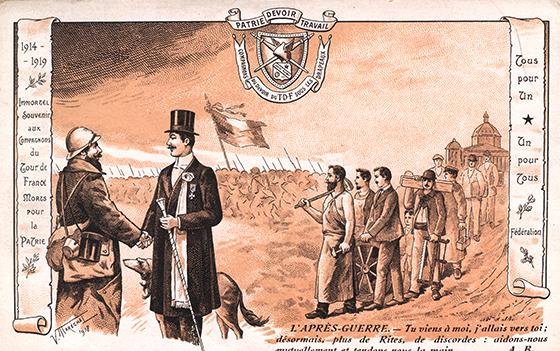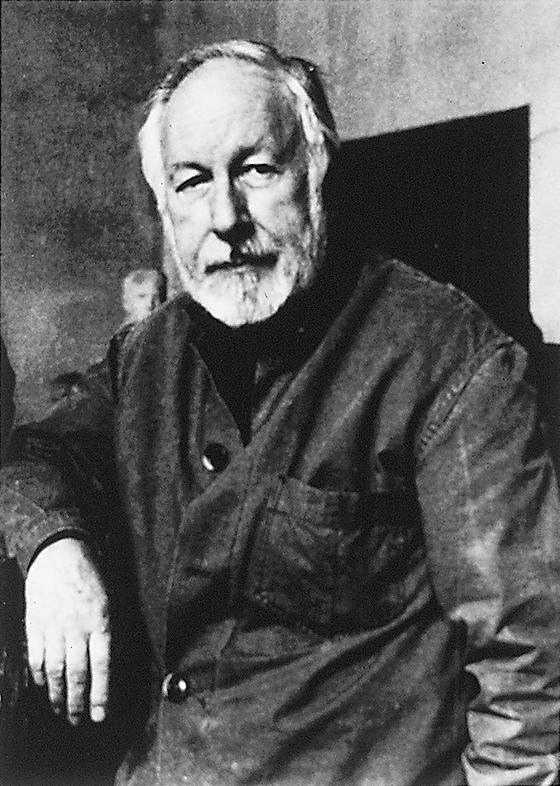20th century
The 20th century saw a deep restructuring of the Compagnonnage. Up to 1914, the compagnons strove to check the decrease of membership by putting in place ‘societies for the protection of apprentices’ that negotiated the best possible conditions for their protégés. In some cities they also organised vocational training. Rapprochements took place between the Devoir, the Union Compagnonnique and the carpenter compagnons du Devoir de Liberté.
The 1914-1918 war was a severe blow to the Compagnonnage. The Tour de France was deserted; many aspirants and young compagnons were killed on the front. Several local branches of the brotherhoods became extinct for lack of members and/or resources.
After the war, efforts were made to gather the pieces and rebuild inside regional federations. There was the Fédération Générale du Compagnonnage founded in 1919 under the prompting of Ernest Boyer, Tourangeau le Bien Aimé, a farrier compagnon (1876-1952), and the Confédération Salomon-Jacques-Soubise, started in 1929 by another farrier, Abel Boyer, Périgord Cœur Loyal (1882-1959). The joiner and locksmith compagnons du Devoir de Liberté, who had joined the Union Compagnonnique, restarted on an independent basis thanks to Pierre Louis, aka Limousin Cœur Fidèle (1906-1986).
When France was partly occupied by German troops and the free zone was under the command of marshal Pétain, the compagnons had good reasons to worry: in both zones freemasons were deemed undesirable and compagnons were often mistaken for them. In 1940, a stonemason compagnon, Jean Bernard aka La Fidélité d’Argenteuil, was able to obtain an interview with Pétain, thanks to a common acquaintance. He persuaded him that the Compagnonnage was not a freemasonic organisation and even gained his support. Thus emboldened, in 1941 he launched the Association Ouvrière des Compagnons du Devoir with an ambitious pyramidal structure in which the brotherhoods had to relinquish a fair part of their autonomy. It was soon officially recognised as being ‘of public interest’ and got a subvention to open its first headquaters in Lyons; but with France still occupied for the most part, only a small fraction of the Compagnonnage were concerned by this evolution.
The negotiations that took place after the country was liberated led to the delineation of Compagnonnage such as we know it to this day. The Association Ouvrière failed in its ambition to gather together all the compagnons: the Union Compagnonnique opted out. The two carpenter brotherhoods (du Devoir and du Devoir de Liberté) merged in 1947 and did the same, as well as the joiner and locksmith compagnons du Devoir de Liberté. They objected to the reforms put in place by the A.O. and moreover, its inception under Pétain’s regime was not accepted by these compagnonnages.
Besides the A.O. and the U.C. the third gathering that embodies the present French compagnonnage was founded in Tours in 1952 under the name of Fédération Compagnonnique des Métiers du Bâtiment.
Throughout the second half of the century, they all opened local branches in many towns, not by making agreements with inn-keepers as in the past, but by owning or renting the building they occupied. They reached well beyond the usual path of the Tour de France as it was practised in the past, now setting foot in Normandy, Brittany, the East and North of France, the Basque country etc. and even beyond the borders in Belgium, Switzerland, England. The Tour de France is becoming the Tour d’Europe.
Officially registered as vocational training organisms and supported by the authorities, they opened sections for apprentices and started offering skill improvement courses to all workers. Their houses could now accommodate young apprentices and compagnons under the same roof.
In 2004, the Association Ouvrière opted for the transition to a mixed gender compagnonnage and the first women (a stonemason) was received in 2006. The other movements followed suit.
During the last decades the three main streams could not avoid inside discordances that resulted in small groups of dissenters trying to form their own independent associations.
Globally, the number of active members is estimated at 10,000.

Compagnons revive their links after WWI

Abel Boyer in his workshop in Asnières in 1932

Jean Bernard (1909-1994)

Merging of the carpenters in 1945 ─ D.R.

Young joiner in training at the compagnons’ in Limoges
